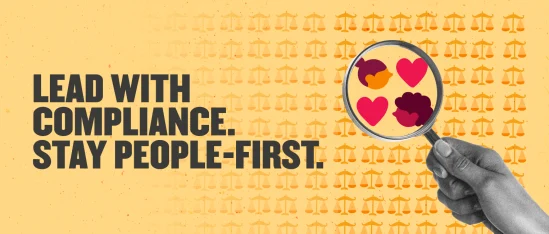A sweeping wave of executive orders and proposed policy changes in the United States is reshaping the workplace fast.
For HR and compliance leaders, this means a shifting landscape across compliance, labor law, DE&I, and immigration.
While these changes are often framed as “employer-friendly,” it’s not just federal contractors feeling the heat. Private companies—especially multi-state employers, globally distributed teams, and organizations with public DE&I commitments—are feeling the impact, too.
The stakes are high. Legal gray areas, cultural tension, changing workforce expectations, and more scrutiny are pulling people leaders in what feels like a thousand different directions.
But HR can still lead the way. With the right strategy, you can stay compliant and true to your people-first values.
To help you navigate uncertain times, here’s a breakdown of how HR can lead confidently without compromising culture.
<<Learn how to turn influence into impact.>>
A quick snapshot: What’s changed and what it means for HR
Here’s a short overview of what’s changed, what it means, and how it may impact your people strategy:

DE&I rollbacks and the rise of “merit-based opportunity”
Diversity, equity, and inclusion have been strategic business priorities for years. But in early 2025, new federal directives started reshaping what’s permitted and what’s at risk.
A shift toward “merit-based” opportunities is changing the landscape. DE&I initiatives are under sharper scrutiny, even within the private sector, and HR teams are now rethinking how to design programs that are both inclusive and compliant.
What’s changed?
Recent federal actions have redefined the government’s stance on DE&I, and they’re already reshaping how private companies perceive, evaluate, and defend their diversity strategies:
- EO 14172. Ends all DE&I programs, roles, grants, and training in federal agencies and contracting.
- EO: Ending Illegal Discrimination and Restoring Merit-Based Opportunity. Revokes EO 11246, removing race- or gender-based hiring preferences in federal contracts.
- DOJ guidance. Reduces federal enforcement of disparate impact claims, narrowing the scope for bias investigations based on outcomes without proven intent.
What does it mean for HR?
Changes to policy are reshaping how HR teams navigate culture, compliance, and risk in today’s environment:
- More scrutiny. Courts and the public are examining DE&I programs, including voluntary ones, more closely than ever before.
- New legal risks. Programs that include identity-based goals or language over ability-based goals could now face legal challenges.
- Unclear boundaries. The ambiguity in new federal guidance makes it harder to determine what’s legally permitted and what’s potentially problematic.
What can HR do now?
Even in a more cautious climate, HR leaders can adapt programs and messaging to stay compliant—and still champion belonging and fairness:
- Audit your DE&I language. Avoid quota-based terms and preference-driven framing.
- Reframe your messaging. Focus on fairness, equity of opportunity, and belonging—anchored in clear business objectives.
- Stay state-compliant. DE&I mandates in states like California, Colorado, and Illinois still apply, regardless of federal changes.
- Remember Title VII still stands. The federal civil rights law prohibiting workplace discrimination has not changed.
DE&I isn’t going away, but it’s evolving.
HR leaders can guide the way by updating language, strengthening intent, and showing that inclusion is a business value, not just a program.
Labor law shake-ups: Wages, overtime, unions, and employee classification
From wage floors to union rights, recent moves in federal labor policy reflect a broader trend toward deregulation, reducing government mandates while increasing employer discretion.
Some may frame these changes and the flexibility they offer as cost-cutting wins, but they come with trade-offs: more compliance responsibilities, potential impacts on morale, and new classification risks for HR.
What’s changed?
These changes are signaling a return to more deregulated labor practices. Here’s what’s changed:
- EO (Mar 2025). Rescinds the $15/hour minimum wage for federal contractors (EO 142026). The new floor is $13.30.
- EO (Mar 2025). Limits union rights in national security agencies.
- Overtime expansion frozen. This proposed increase to the overtime threshold (~$55K/year) is no longer advancing and is frozen or withdrawn.
- Additional reversals. Non-displacement and wage transparency rules for contractors have been rescinded.
What does it mean for HR?
Here’s what these changes could mean for your pay, union, and classification strategies:
- More pay flexibility (with risk). Federal contractors can lower wages, but that may hurt morale, retention, and competitiveness.
- Weaker union protections. While changes apply to federal agencies, they signal a broader trend in how unions are regulated and challenged, including in the private sector.
- Classification in flux. Fewer federal guardrails mean more responsibility falls on employers to get employee classification right or risk penalties.
What can HR do now?
- Anchor compensation locally. Match compensation to city- or state-level wage floors (for example, New York City, San Francisco, Seattle) to avoid reputational and retention risks.
- Review your classification strategy. Especially in strict states like California, where ABC tests still apply.
- Enable transparency. Prepare managers to clearly explain pay and classification decisions to avoid confusion or mistrust.
With looser federal oversight, HR clarity matters more than ever.
Document your decisions, communicate openly, and make sure your people know where they stand to protect trust (and prevent legal trouble).
Immigration and E-Verify: The new frontline of compliance
Hiring global talent? Great! But you’ll have to be prepared.
Immigration is now in the spotlight, and policy is shifting fast. The focus is moving from expansion to restriction, with stronger enforcement, proposed national E-Verify requirements, and less support for bringing global talent onboard.
This means higher audit risk for HR teams, new onboarding responsibilities, growing uncertainty, and more anxiety, even for visa-holding international team members.
What’s changed?
Immigration policy is getting stricter, and HR is on the front lines of what comes next.
- EO (Jan 2025). Declares a border emergency and escalates immigration enforcement.
- Proposed E-Verify mandate. This would require all employers to verify work authorization through E-Verify.
- Revocation of EO 14110. Ends support for skilled STEM/entrepreneur immigration.
What does it mean for HR?
Immigration enforcement is ramping up. For HR teams, that means more audits, more onboarding complexity, and more uncertainty for global talent.
- More audits, more risk. Expect more I-9 inspections, especially if your company has global or distributed teams.
- STEM talent pools could shrink. Ending support for streamlined H-1B visas in STEM positions may make it harder to attract high-skill international candidates.
- Rising anxiety. Visa-holding team members may feel less secure, professionally (job security) and personally (immigration status).
What HR can do now:
HR teams can stay ahead of shifting rules and protect employee trust by taking action now—before audits or policy changes occur.
- Pre-audit your I-9s. Catch and correct any I-9 and visa documentation errors to get ahead of any surprise inspections.
- Train your hiring teams. Make sure they understand E-Verify requirements and timelines.
- Support visa holders. Offer legal resources or advisory access to help international team members navigate uncertainty.
This is about more than compliance. It’s about compassion and supporting your people. HR can be a stabilizing force by staying proactive, people-first, and keeping all their people supported, informed, and included in times of change.
Compliance and culture: HR’s role in leading with clarity
Regulatory volatility doesn’t have to erode company culture.
In fact, it’s in these moments that HR can offer what no one else can: a steady hand, a people-first lens, and a proactive compliance strategy that keeps your business moving forward.
Recommended For Further Reading
4 ways HR can lead now
These practical steps can help HR teams stay compliant while protecting culture and trust:
- Refresh your policies and employee handbook
- Update outdated EEO, affirmative action, or DE&I language
- Rework training content to avoid identity-first or quota-based framing
- Run a compliance scan
- Spot gaps in I-9s, pay equity, DE&I language, and worker classification
- Flag conflicts between state and federal requirements
- Empower your leaders
- Provide communication toolkits focused on fairness, inclusion, and legal clarity
- Prep people managers to handle tough questions confidently and compliantly
- Build cultural resilience
- Ground all messaging in company values, not political trends
- Reinforce your commitment to inclusion, fairness, and opportunity for all
You don’t need to choose between staying compliant and staying true to your culture. In fact, your ability to do both is exactly what will set you apart in 2025.
Lead with clarity by anchoring in your values
Laws will keep changing, and headlines will keep shifting.
But your people are looking to you—not for political stances, but for clarity, compassion, and confidence.
By understanding what’s happening, assessing the impact, and adapting proactively, HR leaders can be a source of stability in a volatile time.
This moment is yours to own.
Stay smart. Stay human. And above all—stay true to your values.


